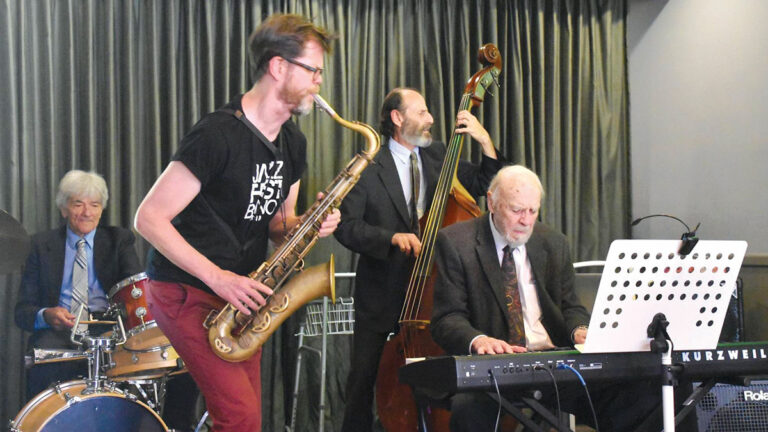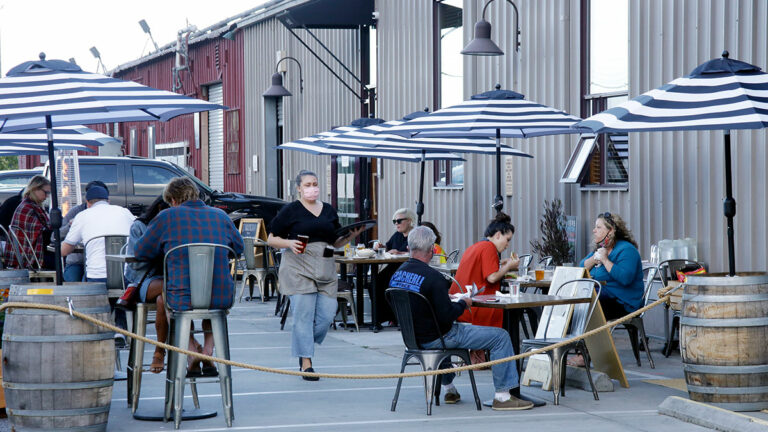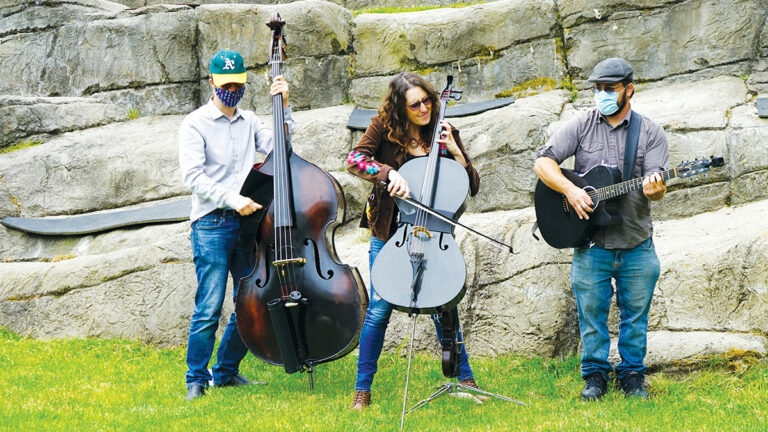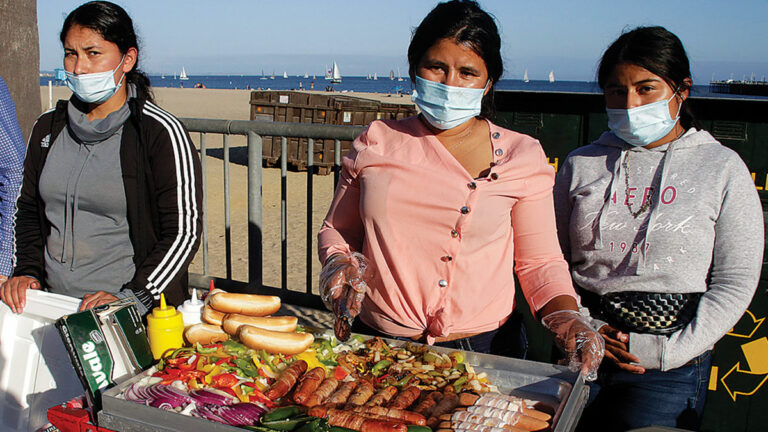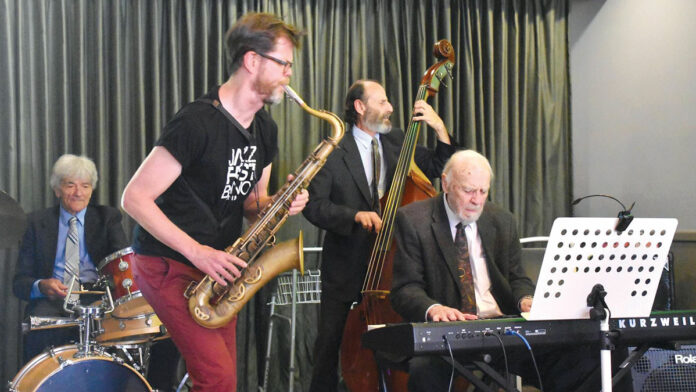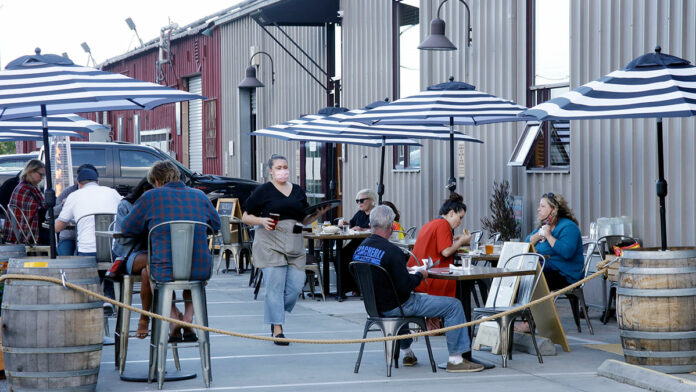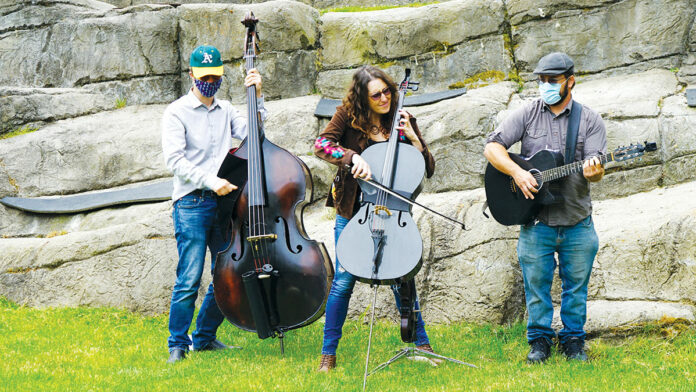Because many in-person events across Santa Cruz County have been canceled or postponed during the pandemic, Good Times is compiling a weekly list of virtual events hosted by local nonprofits, artists, fitness instructors and businesses. To submit your virtual event, send an email to ca******@*******es.sc.
ARTS AND MUSIC
COFFEE OUTSIDE Join the Santa Cruz Museum of Art and History for its new series: Coffee Outside. Enjoy casual conversation and the company of others in this physically distant coffee and conversation club hosted by a rotating cast of MAH artists. The first discussion will be around Octavia Butler’s Parable of the Sower. This book coincides with the exhibition “Beyond the World’s End,” which features the work of Kristina Franklin. Franklin’s work is featured on the cover of a new and timely podcast, Octavia’s Parables. BYO mug or a conversational beverage of your choice. Hot water and self-serve Steeped Coffee packs will be provided courtesy of our friends over at Cat and Cloud. Come beat the social distance blues with us, but don’t forget to wear your mask. Friday, Aug. 14, 9am.
DOWNTOWN SANTA CRUZ MAKERS MARKET We’re back! After five months of closure due to the pandemic, we are beyond excited to be reopening! A lot has changed downtown and that brings change to the Makers Market, too … we are moving! Please note our new location at the 1100 block of Pacific Avenue between Cathcart and Lincoln Streets. Support local makers and artists and shop with more than 40 Santa Cruz County artists and crafters! And don’t forget to stop in and visit the downtown merchants and all of the amazing restaurants. Remember to social distance as you shop, wear your mask, and keep your hands clean. If you’re not feeling well, please stay home. There will be hand sanitizing stations at the market. Sunday, Aug. 16, 10am-5pm. Check out scmmakersmarket.com/markets to see the full lineup of artists.
OUTDOOR ART SHOW Artists Robert Irwin and Wendy Simon are holding an outdoor art show and sale at their home studio, 1415 King St., Santa Cruz. Featuring new works in large mosaiced garden pots, wall hanging mosaics, paintings, and gourd art. Saturday and Sunday Aug. 15-16 from noon to 5 pm. This is a free event and open to the public.
CLASSES
FROM STUCK TO SHINING BRIGHT WORKSHOP Tracie Root supports and guides women to reveal their best selves everywhere in their life. This workshop will help you not only get clarity on your goal but will help you set up a clear path to getting there and beyond. Live on Zoom! Saturday, Aug. 15, 10am. Learn more at gatherinsantacruz.com.
SALSA SUELTA IN PLACE: Free weekly online session in Cuban-style Salsa Suelta for experienced beginners and up. Contact to get a Zoom link. Thursdays at 7pm. salsagente.com.
COMMUNITY
OPERATION GREEN DURING COVID-19 Green Business is smart business. Join the Tri-County Monterey Bay Area Green Business Program and partners for this free webinar! Gain tools to operate green and safe while your business adapts and recovers from Covid-19. Wednesday, Aug. 12, 11am. RSVP at operationgreen_covid19.eventbrite.com.
LUMA BOOK CLUB This is a time of seismic shift, and yet also one of opportunity. Luma Yoga is a community center operating on principles of inclusion, compassion, and, yes, reflection, but make no mistake—also of action. The first step in effective action is gaining knowledge. To this end, Luma is hosting a book club on the topic of racism and social justice issues. The reading groups will be held remotely (for now) over Zoom Thursday nights 7-8:15pm. The purpose of the groups is to learn the endless shapes oppression can take in the world, to recognize our own biases within ourselves, and to move from discomfort to action in support of Black and non-white POC. The groups will be facilitated by Steven Macramalla, a professor of psychology at SJSU. The Club will work on a 3- to 4-week cycle, reading one book per cycle, with several chapters covered each week. For more info visit lumayoga.com. Thursdays at 7pm.
TALES TO TAILS GOES VIRTUAL Tales to Tails goes virtual to create a comfortable, neutral, and fun reading experience. Bring some books, a stuffed animal or your own pet, and come read with us! This is a YouTube livestream event so you might be reading to up to six animals at once. Woo hoo! Caregivers, you can post your child’s first name and city in the comments section, along with the book they are reading, and we’ll read off as many of those names as we can, live, during the break we need to give the dogs. Each week you register we’ll send you your dog bone “punch cards.” These will be dated dog bones your child can color and email to us. The following week, we’ll display them live on the feed. This will also be recorded so if you can’t make it live, the dogs will still be there for you. Every Wednesday, 10-11am. Learn more at santacruzpl.libcal.com/event/6764929.
GROUPS
VIRTUAL YOUNG ADULT (18-30) TRANSGENDER SUPPORT GROUP A weekly peer support group for young adults aged 18-25 who identify as transgender, non-binary, genderqueer, agender, or any other non-cisgender identity. This is a social group where we meet and chat among ourselves, sharing our experiences and thoughts in a warm, welcoming setting. Our meetings will be held on Discord during the shelter-in-place order. For more info, contact Ezra Bowen at tr***@*************er.org.
LGBTQNBI+ SUPPORT GROUP FOR CORONAVIRUS STRESS This weekly LGBTQNBI+ support group is being offered to help us all deal with stress during the shelter-in-place situation that we are experiencing from the coronavirus. Feel free to bring your lunch and chat together to get support. This group is offered at no cost and will be facilitated by licensed therapists Shane Hill, Ph.D., and Melissa Bernstein, LMFT #52524. Learn how to join the Zoom support group at diversitycenter.org/community-calendar.
OUTDOOR
SHARK SCIENCE WEEK For a full week, the Seymour Marine Discovery Center will virtually celebrate Shark Science Week by revealing fascinating facts about these cartilaginous fishes. Explore amazing shark adaptations including their extraordinary senses, the unique ways in which they reproduce, and so much more—all online! Shark Science Week crafts, activities, and videos will be available on the Seymour Center’s website Aug. 9-15. Learn more at: seymourcenter.ucsc.edu/learn/family-activities/family-events/#shark-science-week.
LABSIDE CHATS: A CONVERSATION WITH A SCIENTIST Tune in for a special Shark Science Week Labside Chat with Melissa Cronin, Ph.D. candidate in the Ecology and Evolutionary Biology Department at UCSC, on Thursday, Aug. 13, at 11am to learn more about the conservation of cartilaginous fishes. Join the conversation! Submit your questions in advance for Melissa, then watch the conversation to hear the answers during the live chat. Visit the Seymour Center’s website to submit your questions in advance for each scientist and to access the livestreams at: seymourcenter.ucsc.edu/learn/ongoing-education/labside-chats. Labside Chats are livestreamed the second and fourth Thursday of every month (excluding holidays), and are free. Please support the Seymour Center by becoming a member at seymourcenter.ucsc.edu/get-involved/join or making a donation at seymourcenter.ucsc.edu/get-involved/donate/make-a-donation.
VIRTUAL SCIENCE SUNDAY—FIELD IMMERSION: HOW CURIOSITY, NATURAL HISTORY, AND COLLABORATION HAVE LED TO ECOLOGICAL DISCOVERIES Scientific discoveries are made in a myriad of ways and often start with the simple act of being curious. Natural patterns surround us but take time to truly see. This presentation is about observing patterns, becoming curious about what influences them, and discovering the natural history behind them. It’s also about the rich human collaborations that can result. While exploring the coasts of California and the Baja California peninsula, the speaker has made numerous discoveries of previously unknown or understudied ecological wonders. Please join the Seymour Marine Discovery Center and Diana Steller, Ph.D., research biologist and diving safety officer at Moss Landing Marine Laboratories, to learn about these new discoveries. Sunday, Aug. 12, 1:30pm. To register in advance for the online Science Sunday webinar (required), please visit the Seymour Center’s website: seymourcenter.ucsc.edu/learn/ongoing-education/science-sundays.
RESILIENT COAST SANTA CRUZ COMMUNITY ENGAGEMENT OPPORTUNITY Through Aug. 17, the city of Santa Cruz invites residents to provide feedback through a new virtual engagement platform on how priorities and preferences for adapting seven beach locations between Seabright State Beach and Natural Bridges State Beach and the entire West Cliff Drive transportation corridor to future coastal hazards. Also, download and explore a new immersive and interactive Sea Level Rise Santa Cruz mobile phone application. Both options available in Spanish and English. Access both at the initiative’s website. Learn more at cityofsantacruz.com/government/city-departments/city-manager/climate-action-program/west-cliff-drive-adaptation-and-management-plan.
VIRTUAL ROCKIN’ POP-UP Join the Geology Gents, Gavin and Graham, for weekly conversations about rocks live on Facebook. Each week we’ll explore a different geologic topic, from Santa Cruz formations to tips for being a more effective rockhound. Graham Edwards and Gavin Piccione are PhD candidates in geochronology with the Department of Earth and Planetary Sciences at UCSC. Submit your questions ahead of time on Facebook or by emailing ev****@*************um.org, or during the program live on Facebook. Feel free to include pictures of rocks you’d like identified! Pro-tip: the better the picture, the better the ID. Wednesdays at 3pm. Learn more at santacruzmuseum.org/upcoming-events.
SUPERSIZED FELINES Explore the world of mountain lions, California’s largest cat, with an evening of songs, games, and trivia. Learn safety tips for visiting cougar country and why these elusive animals are an important part of a healthy California landscape. Viewers will be able to post questions and comments during the premiere for a state park interpreter to answer. The program will also be available for later viewing. Free event. Saturday, Aug. 15, 7pm. Like our Facebook page to receive a notification when this pre-recorded program is premiered: facebook.com/BigBasinRedwoodsSP.
NATURALIST NIGHT: SANTA CRUZ HABITATS AND HISTORY Santa Cruz Public Libraries and the Santa Cruz Museum of Natural History have partnered to bring you Naturalist Night! Join fellow nature enthusiasts for monthly explorations of the biodiversity of Santa Cruz County. Each month, Marisa Gomez from the Santa Cruz Museum of Natural History will share the stories of a specific Santa Cruz habitat as we develop our skills as naturalists. This series will feature a presentation as well as an interactive session. This program occurs monthly on the fourth Tuesday from 6-7 pm, with upcoming events Aug. 25 and Sept. 22. Registration is required for Zoom access link. Your registration confirmation email will have the Zoom link in it. Register online: santacruzpl.libcal.com/event/6857442.
MONTEREY’S GRAND SUBMARINE CANYON Dive even deeper—two miles below the ocean’s surface!—into the wonders of Monterey Bay with our virtual exploration of a canyon as grand as any on Earth. This interactive program will be broadcast as a Zoom webinar. California State Parks in Santa Cruz County are offering virtual junior ranger programs for children ages 7-12 during the Covid-19 pandemic. These fun, free Zoom webinars are scheduled Friday through Monday at 10am each week in August. Children receive a digital stamp for each program they attend; after receiving a certain number of stamps, they can earn prizes! Free event. Monday, Aug. 17, 10am. Registration is required. To register, visit tinyurl.com/SantaCruzJuniorRangers.
SLITHERY, SCARY SNAKES? Meet Bandit, our sssweet and cuddly King Snake at Rancho del Oso. You’ll discover that snakes are friend, not foe! This interactive program will be broadcast as a Zoom webinar. California State Parks in Santa Cruz County are offering virtual junior ranger programs for children ages 7-12 during the Covid-19 pandemic. These fun, free Zoom webinars are scheduled Friday through Monday at 10am each week in August. Children receive a digital stamp for each program they attend; after receiving a certain number of stamps, they can earn prizes! Free event. Saturday, Aug. 15, 10am. Registration is required. To register, visit tinyurl.com/SantaCruzJuniorRangers.
SAFETY AND SURVIVAL IN THE FOREST Are you prepared if you get lost in the woods? Learn the essentials you need to pack and how to be a good steward of the forest as you hike. This interactive program will be broadcast as a Zoom webinar. California State Parks in Santa Cruz County are offering virtual junior ranger programs for children ages 7-12 during the Covid-19 pandemic. These fun, free Zoom webinars are scheduled Friday through Monday at 10am each week in August. Children receive a digital stamp for each program they attend; after receiving a certain number of stamps, they can earn prizes! Free event. Sunday, Aug. 16, 10am. Registration is required. To register, visit tinyurl.com/SantaCruzJuniorRangers.
WHERE DO SANDWICHES COME FROM? Dig into an imaginary lunch as we trace it back to the beginning of the universe! This interactive program will be broadcast as a Zoom webinar. California State Parks in Santa Cruz County are offering virtual junior ranger programs for children ages 7-12 during the Covid-19 pandemic. These fun, free Zoom webinars are scheduled Friday through Monday at 10am each week in August. Children receive a digital stamp for each program they attend; after receiving a certain number of stamps, they can earn prizes! Free event. Friday, Aug. 14, 10am. Registration is required. To register, visit tinyurl.com/SantaCruzJuniorRangers.



